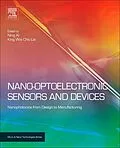Nanophotonics has emerged as a major technology and applications domain, exploiting the interaction of light-emitting and light-sensing nanostructured materials. These devices are lightweight, highly efficient, low on power consumption, and are cost effective to produce. The authors of this book have been involved in pioneering work in manufacturing photonic devices from carbon nanotube (CNT) nanowires and provide a series of practical guidelines for their design and manufacture, using processes such as nano-robotic manipulation and assembly methods. They also introduce the design and operational principles of opto-electrical sensing devices at the nano scale. Thermal annealing and packaging processes are also covered, as key elements in a scalable manufacturing process. Examples of applications of different nanowire based photonic devices are presented. These include applications in the fields of electronics (e.g. FET, CNT Schotty diode) and solar energy. - Discusses opto-electronic nanomaterials, characterization and properties from an engineering perspective, enabling the commercialization of key emerging technologies - Provides scalable techniques for nanowire structure growth, manipulation and assembly (i.e. synthesis) - Explores key application areas such as sensing, electronics and solar energy
Autorentext
Dr Ning Xi is Distinguished Professor of Electrical and Computer Engineering and received his D.Sc. degree in Systems Science and Mathematics from Washington University in St. Louis , Missouri in December, 1993. He received his M.S. degree in computer science from Northeastern University , Boston , Massachusetts , and B.S. degree in electrical engineering from Beijing University of Aeronautics and Astronautics. Currently, he is John D. Ryder Professor of Electrical and Computer Engineering in the Department of Electrical and Computer Engineering at Michigan State University . Dr. Xi received the Best Paper Award in IEEE/RSJ International Conference on Intelligent Robots and Systems in August, 1995. He also received the Best Paper Award in the 1998 Japan-USA Symposium on Flexible Automation. Dr. Xi was awarded the first Early Academic Career Award by the IEEE Robotics and Automation Society in May, 1999. In addition, he is also a recipient of National Science Foundation CAREER Award. His research interests include robotics, manufacturing automation, micro/nano systems, and intelligent control and systems.
Inhalt
Preface
Acknowledgments
About the Editors
List of Contributers
Chapter 1 Introduction
1.1 Overview
1.2 Impact of Nanomaterials
1.3 Challenges and Difficulties in Manufacturing Nanomaterials-Based Devices
1.3.1 Role of Microfluidics
1.3.2 Role of Robotic Nanoassembly
1.4 Summary
References
Chapter 2 Nanomaterials Processing for Device Manufacturing
2.1 Introduction
2.2 Characteristics of Carbon Nanotubes
2.3 Classification of Carbon Nanotubes using Microfluidics
2.3.1 Dielectrophoretic Phenomenon on CNTs
2.3.2 Experimental Results: Separation of Semiconducting CNTs
2.4 Deposition of CNTs by Microrobotic Workstation
2.5 Summary
References
Chapter 3 Design and Generation of Dielectrophoretic Forces for Manipulating Carbon Nanotubes
3.1 Overview
3.2 Dielectrophoretic Force Modeling
3.2.1 Modeling of Electrorotation for Nanomanipulation
3.2.2 Dynamic Modeling of Rotational Motion of Carbon Nanotubes for Intelligent Manufacturing of CNT-Based Devices
3.2.3 Dynamic Effect of Fluid Medium on Nano Particles by Dielectrophoresis
3.3 Theory for Microelectrode and Electric Field Design for Carbon Nanotube Applications
3.3.1 Microelectrode Design
3.3.2 Theory for Microelectrode Design
3.4 Electric Field Design
3.5 Carbon Nanotubes Application-Simulation Results
3.5.1 Dielectrophoretic Force: Simulation Results
3.5.2 Electrorotation (Torque): Simulation Results
3.5.3 Rotational Motion of Carbon Nanotubes: Simulation Results
3.6 Summary
References
Chapter 4 Atomic Force Microscope-Based Nanorobotic System for Nanoassembly
4.1 Introduction to AFM and Nanomanipulation
4.1.1 AFM's Basic Principle
4.1.2 Imaging Mode of AFM
4.1.3 AFM-Based Nanomanipulation
4.2 AFM-Based Augmented Reality System
4.2.1 Principle for 3D Nanoforce Feedback
4.2.2 Principle for Real-Time Visual Feedback Generation
4.2.3 Experimental Testing and Discussion
4.3 Augmented Reality System Enhanced by Local Scan
4.3.1 Local Scan Mechanism for Nanoparticle
4.3.2 Local Scan Mechanism for Nanorod
4.3.3 Nanomanipulation with Local Enhanced Augmented Reality System
4.4 CAD-Guided Automated Nanoassembly
4.5 Modeling of Nanoenvironments
4.6 Automated Manipulation of CNT
4.7 Summary
References
Chapter 5 On-Chip Band Gap Engineering of Carbon Nanotubes
5.1 Introduction
5.2 Quantum Electron Transport Model
5.2.1 Nonequilibrium Green's Functions
5.2.2 Poisson's Equation and Self-Consistent Algorithm
5.3 Electrical Breakdown Controller of a CNT
5.3.1 Extended Kalman Filter for Fault Detection
5.4 Effects of CNT Breakdown
5.4.1 Current-Voltage Characteristics
5.4.2 Infrared Responses
5.5 Summary
References
Chapter 6 Packaging Processes for Carbon Nanotube-Based Devices
6.1 Introduction
6.2 Thermal Annealing of Carbon Nanotubes
6.3 Electrical and Optical Responses of Carbon Nanotubes After Thermal Annealing
6.4 Parylene Thin Film Packaging
6.5 Electrical and Optical Stability of the CNT-Based Devices After Packaging
6.6 Summary
References
Chapter 7 Carbon Nanotube Schottky Photodiodes
7.1 Introduction
7.2 Review of CNT Photodiodes
7.3 Design of CNT Schottky Photodiodes
7.4 Symmetric Schottky Photodiodes
7.5 Asymmetric Schottky Photodiodes
7.6 Summary
References
Chapter 8 Carbon Nanotube Field-Effect Transistor-Based Photodetectors
8.1 Introduction
8.2 Back-Gate Au-CNT-Au Transistors
8.3 Back-Gate Ag-CNT-Ag Transistors
8.4 Back-Gate Au-CNT-Ag Transistors
8.5 Middle-Gate Transistors
8.6 Multigate Transistors
8.7 Detector Array Using CNT-Based Transistors
8.8 Summary
References
Chapter 9 Nanoantennas on Nanowire-Based Optical Sensors
9.1 Introduction
9.2 Nanoantenna Design Consideration for IR Sensors
9.2.1 Optical Nanoantennas Combined with CNT-Based IR Sensors
9.3 Theoretical Analysis: Nanoantenna Near-Field Effect
9.4 Fabrication of Nano Sensor Combined with Nanoantenna
9.5 Photocurrent Measurement on Nano Sensor Combined with Nanoantenna
9.6 Summary
References
Chapter 10 Design of Photonic Crystal Waveguides
10.1 Introduction
10.2 Review of the Photonic Crystal
10.3 Principle for Photonic Crystal
10.4 Phototonic Band Gap of Photonic Crystal
10.4.1 Effect from Dielectric Constants
10.4.2 Effect from Different Structures
10.5 Photonic Crystal Cavity
10.5.1 Basic Design of Photonic Crystal Defect
10.5.2 Defect from Dielectric Constants
10.5.3 Defect from Dielectric Size
10.5.4 Effect from Lattice Number
10.6 Design and Experimental Results of Photonic Crystal Cavity
10.6.1 Design
10.6.2 Photoresponses of CNT-Based IR Sensors with P…
